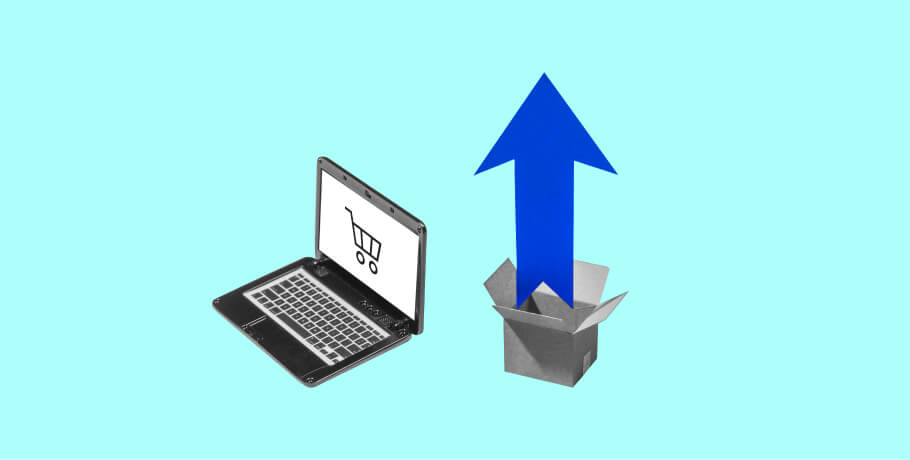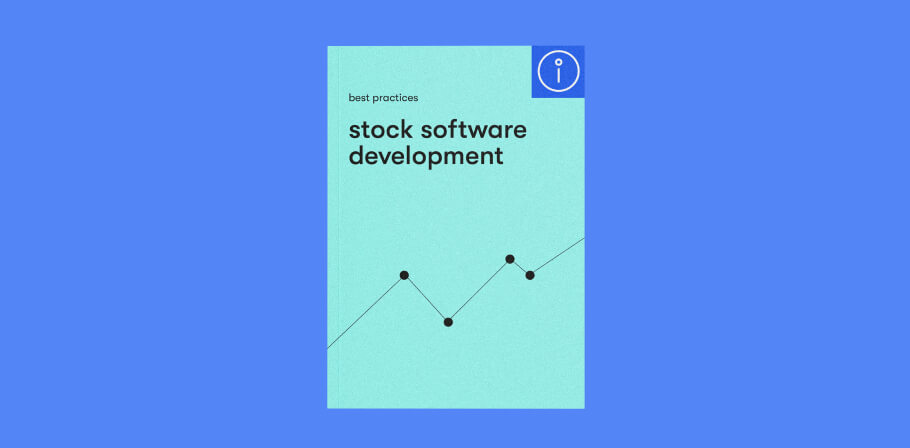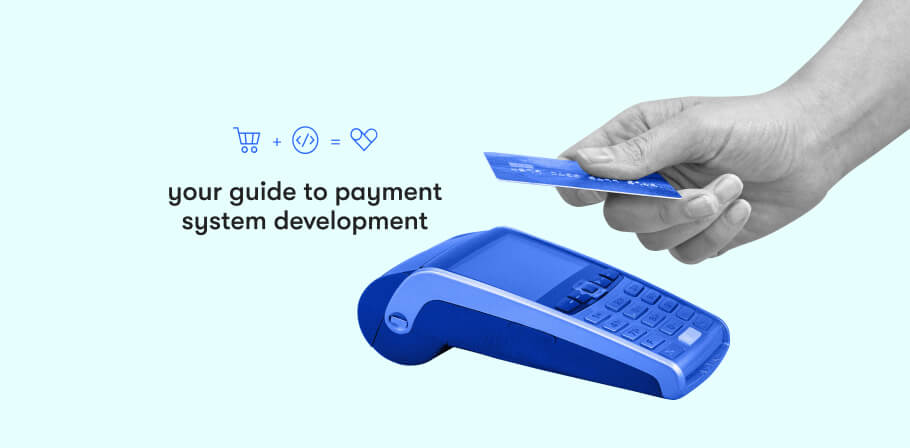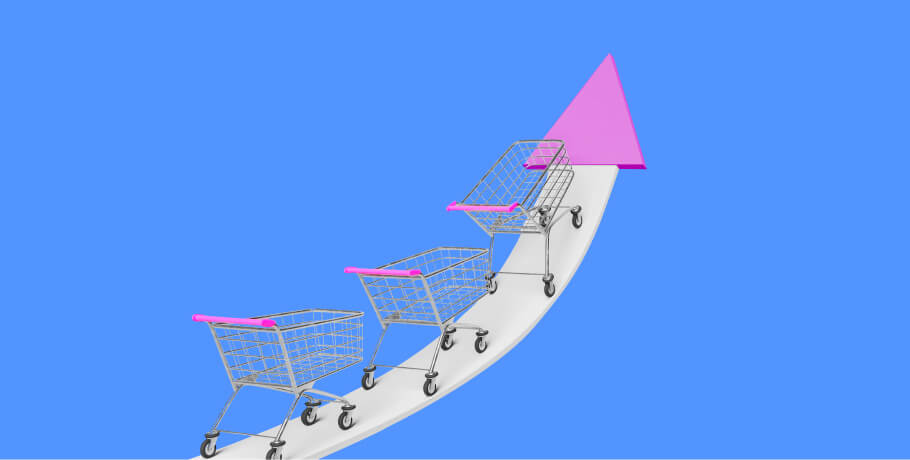In today's business landscape, launching innovative products can be a game-changer for businesses seeking to drive growth. This comprehensive guide will explain the new product development process, with a primary focus on software product development. We aim to simplify the journey of transforming an innovative idea into a market-ready product, providing you with in-depth insights, strategic planning steps and potential measures to mitigate risks along the way.
What is new product development (NPD)?
New product development (NPD) is a comprehensive term that refers to the process of bringing a new product or service to market. Beyond just the introduction of a new product, it involves conceptualizing an idea, researching the market, designing, developing, and finally, launching the product to the public.
It's a strategic, organized, and well-planned process that transforms a market opportunity into a product available for sale, designed to offer solutions to customer needs and contribute to business growth.
There are numerous key drivers of new product development for all types of businesses beyond startups:
- Competition: A business may need to introduce new products to differentiate themselves from others and create a new competitive advantage.
- Advances in technology: Technological advancements often drive new product development, as they can create opportunities to offer a value that hasn't existed before.
- Changing customer needs: As customer preferences, lifestyles, and needs shift over time, businesses need to evolve and develop new products in response to cater to those changes effectively.
- Market expansion: New product development provides opportunities for businesses to explore new markets and customer segments, thus expanding their reach and potential customer base.
- Regulatory changes: Changes in industry regulations or standards may require businesses to develop new products that comply with these regulations.
- Business growth: Innovation in product offering is a key driver of business profitability. New products often create an additional revenue stream for businesses.
- Sustaining market presence: Regular introduction of new products or product updates can help businesses maintain their visibility and relevance in the market.
- Risk management: New products can help diversify a company’s offerings, spread risk across different products and avoid dependence on one product.
7 steps of the new product development process
The new product development process consists of seven stages that guide businesses through creating a new product:
- Idea generation
- Idea screening
- Concept development and testing
- Marketing strategy and business analysis
- Product development
- Test marketing
- Product launch
All stages of product development are integral to ensuring the product's success and longevity in the market. In this section, we will delve into the details of each step and explore the NPD team's key activities and considerations.
Note: Though the stages appear linear, in fact they can overlap and show more as a cyclical process, with each stage containing elements from other stages as necessary to move forward.

Step 1: Idea generation
The first stage of the NPD process is idea generation. This is where the journey starts: the team generates and explores new product ideas through brainstorming sessions, customer feedback, market research, and observing industry trends. The ultimate goal is to generate a pool of product ideas that align with the market needs and company goals.
Fair enough, only a handful of generated ideas will proceed to the next stage, but idea generation is the starting point for innovation. This stage sets the foundation for successful product development and business growth.
There are numerous ways to kindle the spark of a promising concept:
- Market research: By keeping a finger on the pulse of the market, observing trends, identifying customer needs, and studying competitors, you can glean valuable insights that spur creative thinking.
- Employee inputs: In many companies, the best product ideas come from the employees themselves who interact with the product and customers on a regular basis. Formal brainstorming sessions or existing channels for sharing innovative ideas can be sources of inspiration.
- Customer feedback and reviews: These can provide invaluable insights into customer requirements, what issues they are facing, and what improvements they’d like to see. Direct user feedback is often a goldmine for product enhancement suggestions and potential new features.
- Innovation from within: It’s also worth looking at existing products and processes within your own organization. Can they be improved, updated, or even used as a basis for a new product?
- Technological advancements: With the rapidly changing tech landscape, new technologies often provide the basis for innovative software product ideas.
When it comes to the roles within the product development team who should actively participate in this stage, it's vital to include a broad spectrum of different perspectives. Cross-functional collaboration is particularly valuable as it brings together diverse expertise from different departments, fostering innovative thinking.
Key participants typically include:
- Product managers: As vision-setters and strategy designers, product managers play a crucial role in guiding the process of idea generation, providing inputs based on their knowledge of the market and customers.
- Designers and developers: These team members can offer insights based on their expertise and often contribute innovative features and functionalities.
- Sales and marketing team: Given their direct interaction with customers and understanding of the competitive landscape, inputs from sales and marketing team members are invaluable.
- Customer service representatives: As individuals who face customers’ queries and issues daily, they can offer firsthand insights into the needs and pain points of the customers.
Remember, each employee, regardless of their role, can be a source of new ideas given their unique perspectives and experiences. Fostering an open culture where these ideas are encouraged and valued is key to a successful idea generation process.
“Give everyone the opportunity to speak, as some people find it more difficult to speak in public. Encourage them to speak up. Otherwise, they may keep their ideas to themselves. Build a climate of trust so people can express even their boldest ideas.”

Step 2: Idea screening
After the glut of ideas brought by the ideation stage, it’s time for idea screening, the stage where you evaluate and validate potential product ideas to decide which ones are worth pursuing further.
Idea screening is necessary to ensure judicious utilization of resources by focusing on ideas with the most potential. This stage avoids costly mistakes by weeding out ideas that don’t align with the company's strategy, are not feasible, or don’t offer a clear market advantage.
Several methodology frameworks offer effective tools to evaluate product ideas effectively:
- SWOT analysis: Evaluate the strengths, weaknesses, opportunities, and threats associated with a particular product idea. This analysis would give a comprehensive understanding of the potential of your product in the context of its proposed market.
- Product-market fit: Define your target market along with your potential market share, and identify whether the proposed product caters to an existing need and how it stands compared to competition in the market.
- Feasibility analysis: Look at available resources, including time, budget, and staff, to realistically understand whether it's feasible to develop the product.
- Risk assessment: Acknowledge possible risks involved in the development and launch of the product.
Other methods to apply include opportunity scoring, decision matrices, and Pugh analysis.
The key actors in this stage are generally key stakeholders — top management and heads of departments — who can assess the alignment of the product idea with the company's objectives and capabilities. Product managers aid them in the process, providing a compelling story about the presented ideas supported by prioritization, data and their experience. Also, the product development team, including designers, and developers, should be involved to evaluate technical feasibility.

The key outcomes and deliverables expected at the end of this stage are:
- A refined list of viable product ideas: At the end of the screening process, you're left with a few product ideas that have the highest potential and are the most aligned with your strategy and goals.
- In-depth analysis report: A detailed report on the results of the SWOT analysis, feasibility study, product-market fit, and risk assessment gives a robust understanding of each viable product idea.
Remember, there's no foolproof method to predict a product's success, but a thorough idea screening process backed by comprehensive analysis and expert input can significantly increase the odds of developing a winning product.
Common pitfalls to avoid during idea screening:
- Using only one resource or method for the product idea evaluation. It’s better to differentiate and cross-check your idea.
- Making exaggerated assumptions about the market size and potential sales or users. By the end of the day, existing stats, common sense and simple math should be your best friends.
- Proceeding only with one way of calculating the possible market. Make top-down and bottom-up calculations to check your assumptions about the potential market size.
- Not talking to anyone else and doing it solely on your own or within the team. Try to talk to market consultants and see their perspective to get more context.
- Not talking to potential customers about the problem you’re trying to solve with your new product. Again, this one is crucial for new product development.
GET YOUR PRODUCT DEVELOPMENT RIGHT WITH OUR EXPERT TEAM
Avoid costly mistakes and take your product to market confidently with EPAM Startups & SMBs.
Step 3: Concept development and testing
Following the screening stage, you'll have shortlisted the most promising ideas. Now, it's time to refine these ideas into detailed product concepts and rigorously test them for viability. This pivotal stage is known as concept development and testing.
Concept development refers to the process of elaborating the basic product idea into comprehensive product concepts. It involves developing detailed descriptions of the product, its intended target audience, explaining how it will meet customer needs and how it differs from existing products. The concept should illustrate in lucid terms what the product is, what problems it solves, and its unique selling proposition.
The concept testing phase of product development involves presenting the fully devised product concept to a group of target consumers to check their response. This can be accomplished through qualitative methods like focus groups or in-depth interviews, or quantitative testing methods like concept testing surveys.
The objective is to evaluate the product concept's appeal and the value it presents to customers. Feedback should extend to all aspects, including the product's functionality, comparative advantages, potential pricing, and distribution strategy. This analysis helps identify any necessary adjustments before continuing with development, reducing the likelihood of costly changes later on.
“Catering to customers’ needs is the main source for generating new hypotheses for NPD, and Steve Blank's “get out of the building and talk to customers” mantra is still relevant today. Without understanding their needs, there’s no point in writing even a single line of code. By adopting a user-centered approach while conceptualizing the future product’s idea, businesses can deliver something that offers value, convenience, and a seamless user experience.”

For product owners and managers moving through this stage, consider the following practical tips:
- Be thorough in your descriptions: The more detailed your product concept, the better feedback you'll get. Don't shy away from explaining intricate features or unique selling points.
- Use visuals: If possible, utilize sketches, drawings, 3D modeling, or infographics to make your concept more tangible during concept tests.
- Choose your test group wisely: Be sure to select a representative sample of your target market for testing. These people will provide the most accurate response to your product concept.
- Value negative feedback: Negative or constructive feedback is equally important as positive feedback. It helps identify potential issues before progressing further into development.
- Stay flexible: Be open to change based on the feedback received during the testing phase. Adaptability might just be the secret sauce to your product's success.
The end result of this stage should ideally be a well-defined and tested product concept that has been validated by your target audience, along with actionable customer feedback to guide the upcoming stages of development.
Step 4: Marketing strategy and business analysis
With a well-defined product concept in hand, the next step in the new product development cycle is to craft a robust product marketing strategy and conduct a comprehensive business analysis. This stage bridges the gap between the concept and the finished product, setting a roadmap for its successful launch and commercialization.
Marketing strategy development
Crafting a strategic marketing plan is key to placing your product in the market strategically. This involves:
- Target market analysis: Understand your audience demographics, behaviors, needs, and preferences and bring it all together with user persona mapping.
- Product positioning and USP: Determine how your product will be positioned in the competitive landscape and define its unique selling proposition.
- Pricing strategy: Plan the pricing structure of your product considering costs, profit margins, customer willingness to pay, and competitor pricing.
- Distribution strategy: Decide how and where the product will be made available to the customers.
- Promotion strategy: Plan effective ways of creating awareness and generating demand for your product.
Business analysis
This involves evaluating whether your product would be profitable for your business:
- Cost estimation: Calculate the overall costs associated with the development, launch, and long-term support of the product.
- Sales forecasts: Based on your market analysis, forecast the expected sales volume and revenue.
- Profit analysis: Measure the anticipated profitability by factoring in costs and expected revenue.
The deliverables of this stage include a detailed marketing strategy plan and a comprehensive business analysis report. Together, these equip you with the essential data and strategy to navigate the journey towards your product's successful development and launch confidently.
Remember, the better the research and planning at this stage, the stronger foundation you'll have for your product's successful development and launch in the market. Startups often face limited resources, making this step absolutely pivotal in avoiding costly mistakes and maximizing return on investment.
Step 5: Product development
Once the concept is validated and a solid marketing strategy is in place, we stride into one of the most intricate stages in the new product development process — product development, or rather, product engineering. This phase focuses on transforming the well-conceived and tested product concept into an actual, tangible product.
The primary goal is to construct the product blueprint into a market-ready product while adhering to specified requirements and quality standards. Here's how it generally unfolds:
1. Design and prototyping phase
This product development stage details out the new product design process, including user interface and experience design. It involves creating sketches, wireframes, prototypes, and design specs.
Prototyping plays a quintessential role. The design team creates a simplified and easily adjustable version of your product, which can help visualize and test how the final product will work.
Prototypes vary in complexity from simple sketches or diagrams to interactive models that closely resemble the final product. This largely depends on your product and resources.
Key aspects of prototyping include:
- Creating the prototype: Depending on complexity and nature of the product, this may range from paper sketches, visual mock-ups, 3D models, to fully functioning scaled-down versions of the product.
- Prototype testing: This involves getting the prototype into the hands of potential or existing users. The goal is to identify potential issues and gain feedback to iteratively improve the product. Usability tests should address questions like: Does the product solve the problem it's supposed to solve? Is it user-friendly? Is the design intuitive and pleasing? To design your own tests, you can rely on this post with usability test script samples.
2. Development phase
Also known as the build phase, it includes coding, developing software components, and integrating different parts of the product.
Building a Minimum Viable Product (MVP) is typically the first product engineering iteration. An MVP is a functional version of the product with just enough features to attract early users and gather maximum validated insights about customers with the least effort.
In building an MVP, businesses must:
- Identify and understand the core features: Streamline the features that solve fundamental problems for users, focus on these for the MVP.
- Develop the MVP: Given its scale, this may require a lesser amount of resources compared to full-fledged product development.
- Test the MVP: Similar to prototype testing, but with an MVP, you can also measure the product's market acceptance level.
- Iterate and improve: The learnings from the MVP should guide further development. Features can then be added or improved based on regular user feedback and following feature prioritization matrices like RICE or MoSCoW.
3. Quality assurance phase
At this stage, the product or its prototypes are being rigorously tested for functionality, usability, performance, and compatibility. It involves systematic testing to ensure the developed product aligns with the end-user expectations and meets the set benchmark of quality. Any bugs or issues found are addressed and fixed.
One of the common principles often applied to improve testing efficiency is 'shift-left'. Shift-left testing is an approach where testing is performed earlier in the life cycle. It means involving testing from the beginning stages of the development process, parallelly with the development activities. The idea is to detect and address issues earlier when they are less expensive and quicker to fix.
Among the key product engineering methodologies to be leveraged during step 5 are:
- Agile methodology: An iterative approach to product development which emphasizes flexibility, collaboration, and customer satisfaction.
- Lean product development: This approach seeks to reduce waste and optimize efficiency at every stage of the development process.
- Scrum framework: Within the Agile methodology, Scrum is a popular framework that focuses on delivering the highest value in the least time.
- DevOps approach: This aims to unify software development and software operation, promoting collaboration between different roles and improving speed and quality.
- Continuous integration/continuous deployment (CI/CD): This practice involves regularly integrating code changes and deploying them to the end product to ensure quick error detection and efficient product delivery.
Getting the product development phase right is central to the successful translation of innovative concepts into marketable products. It's where ideas start shaping into usable, customer-ready software or products, laying the foundation for commercialization.
“At this stage, I couldn't stress the importance of close team collaboration (UI/UX, developers, QA, BA, and PM) enough. Everyone should be on the same page regarding the final result. Does your team have a shared vision of the product? Make sure it does.”

Step 6: Test marketing
Once the product has passed the internal quality assurance tests, it's time to put it through the paces in the real world. Test marketing, the sixth step in the new product development process, provides invaluable feedback before the full-scale launch, giving businesses an opportunity to fine-tune their product development strategy.
Test marketing can help predict the product's acceptance on a wider scale and assess how it performs under realistic market conditions. It can also provide essential insights into the effectiveness of your pricing, distribution channels, and promotional strategies.
There are several common methods of test marketing:
- Focus groups: These are small, demographically diverse groups of consumers who participate in guided discussions about the product. For digital products, this can involve online focus groups using tools like video conferencing. The facilitator can discuss different aspects of the product and marketing strategy, gauging reactions and gathering in-depth insights.
- Beta testing: This involves releasing the product to a select group of users before the official launch. The users are asked to use the product under normal conditions and provide feedback about their experience. Beta testing, common in software production, allows for real-world testing and often uncovers issues not found during internal testing.
- Soft launch: Similar to beta testing, a soft launch is a low-key product release to a restricted audience. It allows businesses to analyze reception and make final adjustments before a wide-scale launch.
Keep in mind that while test marketing could save businesses from costly failures, it can also prove expensive and time-consuming in its own right. Therefore, it's essential to strategically identify the areas you want to test, carefully choose your methods, and judiciously interpret and apply the results.
Ultimately, test marketing can ensure that your official product launch is as finely tuned and effective as possible, increasing the chance of a successful reception in the marketplace.
Step 7: Product launch and commercialization
Finally, the carefully designed, rigorously tested, and market-approved product is ready to meet its consumers in the wider market. This is the stage of product launch and commercialization, where every effort and action are directed towards a successful market introduction of your product.

Stages in a product launch typically include:
- Pre-launch planning: Define launch goals, plan your launch strategy, decide the launch date, and prepare your marketing materials.
- Launch: The product is introduced to the market; this involves the promotion via chosen channels, press releases, social media announcements, and possibly a launch event.
- Post-launch evaluation: After the product launch, initiatives should be assessed to gauge performance and learn for the future.
After an idea is developed, tested, and made into a final product, commercialization is the next essential step to generate revenue from it. It's during this stage that a product moves from the theoretical or conceptual phase into the hands of customers.
The process of commercialization involves several key steps:
- Marketing and promotion: Creating awareness about your product among potential customers. This can include advertising campaigns, social media marketing, email marketing, content marketing, and more.
- Sales strategy: Finalizing how you will sell your product and who will sell it. This could involve deciding between selling directly to consumers, using a sales team, or partnering with distributors.
- Distribution management: Managing how and where your product will be available. It could be your own online platform, partner sources, or both.
- Customer support: Establishing a system to handle customer inquiries and problems after purchasing your product, including setting up 24/7 tech user support. Good customer service can impact your brand image and customer loyalty significantly.
To gauge your product performance with the users, you might want to track the following metrics:
- Sales metrics: Including total sales, average order size, sales by distribution channel or region.
- Marketing metrics: Such as reach, impressions, website traffic, conversion rates.
- Customer metrics: Including customer acquisition costs, churn rates, net promoter score.
- Product adoption metrics: These might include active users, engagement rates, feature adoption rates.
Remember, the ultimate goal of commercialization is not just to launch a product but to ensure that the product reaches its intended market effectively and generates expected profits. It's an ongoing process where strategies may need constant evaluation and adjustments based on market feedback and changing market dynamics.
At this stage though, be sure to celebrate this significant milestone with your team before moving to the ongoing processes of product lifecycle management and further iterations. Launching a product is a massive achievement, marking the start of a new chapter in your product's journey.
Why you need a tech partner to develop a new product
New product development brings along various challenges. For instance, factors such as inadequate market research, poor planning and resource allocation, and technological challenges contribute most to the failure. In other words, the inconsistent approach to the planning phase and development process ruins everything.
At the same time, many companies, particularly startups and SMBs, often face challenges in managing project capacities and rapidly filling new positions for NPD. Collaborating with an enterprise offers the advantage of accelerated outcomes, as large vendors provide access to a broader pool of resources, expertise, knowledge, resources, and specialized capabilities at each step of the product’s creation.
Business benefits of engaging a technology partner:
- Access to specialized expertise: Developing an innovative product requires expertise in specific technical areas. Partnering with a company with the necessary technical knowledge and skills helps translate your idea into a viable product.
- Accelerated development and product innovation: Technical partnerships bring the experience and capabilities to expedite the product development process. Businesses can access advanced technologies, development frameworks, and tools that facilitate faster and more efficient development. This collaboration encourages innovation by bringing to the table fresh perspectives and ideas.
- Reduced development costs and risks: You can leverage the partner's existing infrastructure, resources, and technical capabilities, reducing the need for significant investments in specialized equipment, personnel, or research. This shared responsibility mitigates risks and enhances the project’s financial viability.
How we can help you succeed in new product development
At EPAM Startups & SMBs, we combine our 30+ years of experience, engineering excellence, product mindset, agile methodologies, and multidisciplinary teams to create market-winning digital products.
- Product consultants available to validate your product idea, business model, technology, and talent strategy.
- You can pick from a pool of 50,000+ tech professionals available to start within 1 to 3 weeks. With clear-cut processes of collaboration, you are guaranteed transparent staffing and talent that matches your set requirements.
- You can opt for a dedicated team to take over all the stages of new product development, with experienced product and project managers available to assist.
A case in point: product engineering for Inigo
Inigo has partnered with EPAM Startups & SMBs to co-create tailored software solutions that prioritize security and functionality. Together, these solutions empower businesses with the tools they need to leverage GraphQL confidently, enabling seamless integration and unlocking its vast potential.
- The client: Inigo, an SaaS startup creating a new GraphQL security and management platform. With a robust platform at its core, Inigo assists developers, DevOps engineers, and security architects in effectively harnessing GraphQL's power.
- The challenge: Sourcing top-tier talent can often pose a significant challenge, especially for startups. The main challenge for Inigo was finding experienced team players that would engage to work full-time on their project. They looked for a partnership that would augment their product team and cater to their project's specific requirements.
- Solution: EPAM Startups & SMBs team matched the client with our in-house engineers who met their expectations of work ethics, professional characteristics, and proficiency in the Go development language.
- Business results: Within a year of cooperation, the Inigo team, including our Go developers, built the platform from scratch and successfully launched it onto the market.
PRODUCT ENGINEERING AT ITS FINEST
Get our FAANG-grade software engineers and consultants working on your product. We’re a vendor of choice with 30+ years of hands-on experience.
Closing words
In today's dynamic business landscape, developing a new product requires a deep understanding of emerging trends, proper planning, and technical proficiency. Therefore, it is essential to have a strategic vision that translates into developing products capable of driving bottom-line results.
Fair enough, each product development project is unique, and the specific challenges may vary depending on the industry, product type, and other factors. However, effective planning, communication, and adaptability are essential to successfully bringing a new product to market.
Emerging technology helps forward-thinking business owners thrive in the somewhat uncertain business landscape of today. In this regard, launching a new product might be a transformative milestone for businesses of all sizes.
Explore more new product development guides
- How to build a mobile banking app
- How to create an inventory system
- How to make a personal budget app
- How to create a marketplace app
- How to make a payment gateway system
- How to make an ecommerce mobile app
- How to create a content management system
- How to develop a fitness app
- How to make a food delivery app
- How to create an educational app
- How to create a dating app
- How to create a money transfer app
FAQ

Since 2011, Dmitri has been helping business readers navigate the technology market through expert analysis and editorial work. At EPAM Startups & SMBs, Dmitri shows startups and SMBs across industries how to drive business value from their software engineering investments.
Since 2011, Dmitri has been helping business readers navigate the technology market through expert analysis and editorial work. At EPAM Startups & SMBs, Dmitri shows startups and SMBs across industries how to drive business value from their software engineering investments.
Explore our Editorial Policy to learn more about our standards for content creation.
read more

















